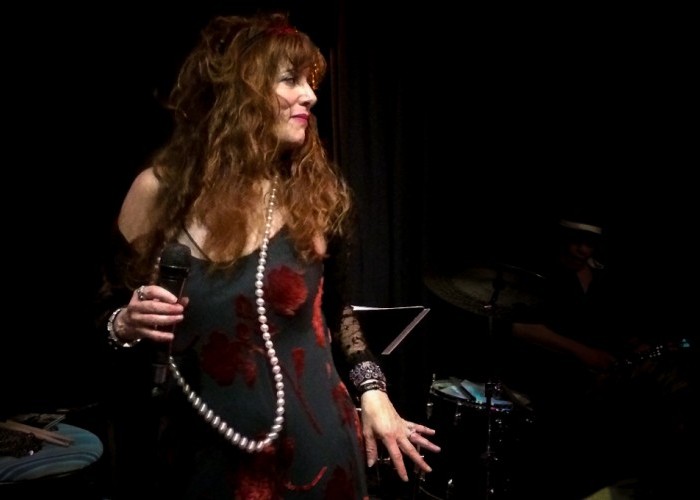Oct 28, 2025 10:47 AM
In Memoriam: Jack DeJohnette, 1942–2025
Jack DeJohnette, a bold and resourceful drummer and NEA Jazz Master who forged a unique vocabulary on the kit over his…

San Francisco-based vocalist Roberta Donnay pays tribute to Louis Armstrong on her new album.
(Photo: Eddy Bee Images)When you’re in love, it’s easy to lose yourself in the allure of your beloved. Just ask Roberta Donnay: The San Francisco-based chanteuse has been infatuated with Louis Armstrong for much of her life. So, when she decided to record a tribute album, My Heart Belongs To Satchmo (Blu Jazz), her priorities were clear.
“Honestly, I wanted to copy him as much as I could,” Donnay explained. “I’ll copy not just his phrasing, but the actual notes he sang. You can’t go wrong in copying him as either a singer or an instrumentalist, because he swings.”
Through her apprenticeship as a singer with Dan Hicks & His Hot Licks, Donnay intensified her empathy with and insights into older repertoire. Producer Orrin Keepnews took her under his wing and helped shape her style. Eventually, she formed The Prohibition Mob Band, with whom she released two albums, A Little Sugar in 2012 and Bathtub Gin in 2015.
Both drew from the sound and spirit of early jazz. So does Donnay’s new release, though with its focus exclusively on one artist whose legacy is vital and recognizable.
Donnay and co-producers/co-arrangers Sam Bevan and Matt Wong chose some tunes that frequently have been recorded—such as “Sweet Georgia Brown” and “On The Sunny Side Of The Street”—as well as “I’m Shootin’ High,” “That’s My Home” and other relative obscurities.
With her languid vocal delivery, Donnay doesn’t evoke her hero’s rough timbre. Plus her range made it necessary to change keys from his original versions.
“Armstrong had this very rhythmic orientation with a lot of personal-isms,” said Wong, 19, a jazz composition major at the Manhattan School of Music. “Because of that, the arrangements on his records are a little edgier. Roberta’s phrasing is much more relaxed and behind the beat; she sings where a horn player might play the melody behind a singer.”
The band’s goal was to stay close to a classic jazz aesthetic. “I said to the horn players, ‘Please don’t play too many notes,’” Donnay said. “I said, ‘Go back to the first time you listened to jazz, back when you were a kid. Come to this music from that place. Also, when you’re taking a solo, you can’t quote anything from after 1939.’”
One track, though, does deviate from the Armstrong aesthetic. “Pennies From Heaven” opens with trumpeter Rich Armstrong playing the four-bar theme in free time, after which Bevan comes in on bass. That’s the entire instrumentation, as Donnay sings within and in front of harmonies she layered with Annie Stocking.
“Dan Hicks wrote the alternative lyrics and the arrangement,” Donnay said, referring to the bandleader who died in 2016. “We worked on it, but I don’t think we ever performed it. We never recorded it. Then Sam said, ‘Let’s just do bass and trumpet.’ The first half is completely Dan’s arrangement, and we rewrote it for the second half.
“It’s an honor and a privilege to sing such great music. Plus, I figured I wouldn’t make any money as a songwriter. So,” she concluded, “I might as well sing jazz and have fun.” DB

Jack DeJohnette boasted a musical resume that was as long as it was fearsome.
Oct 28, 2025 10:47 AM
Jack DeJohnette, a bold and resourceful drummer and NEA Jazz Master who forged a unique vocabulary on the kit over his…

Goodwin was one of the most acclaimed, successful and influential jazz musicians of his generation.
Dec 9, 2025 12:28 PM
Gordon Goodwin, an award-winning saxophonist, pianist, bandleader, composer and arranger, died Dec. 8 in Los Angeles.…

Nov 13, 2025 10:00 AM
For results of DownBeat’s 90th Annual Readers Poll, complete with feature articles from our December 2025 issue,…

Flea has returned to his first instrument — the trumpet — and assembled a dream band of jazz musicians to record a new album.
Dec 2, 2025 2:01 AM
After a nearly five-decade career as one of his generation’s defining rock bassists, Flea has returned to his first…

To see the complete list of nominations for the 2026 Grammy Awards, go to grammy.com.
Nov 11, 2025 12:35 PM
The nominations for the 2026 Grammy Awards are in, with plenty to smile about for the worlds of jazz, blues and beyond.…








